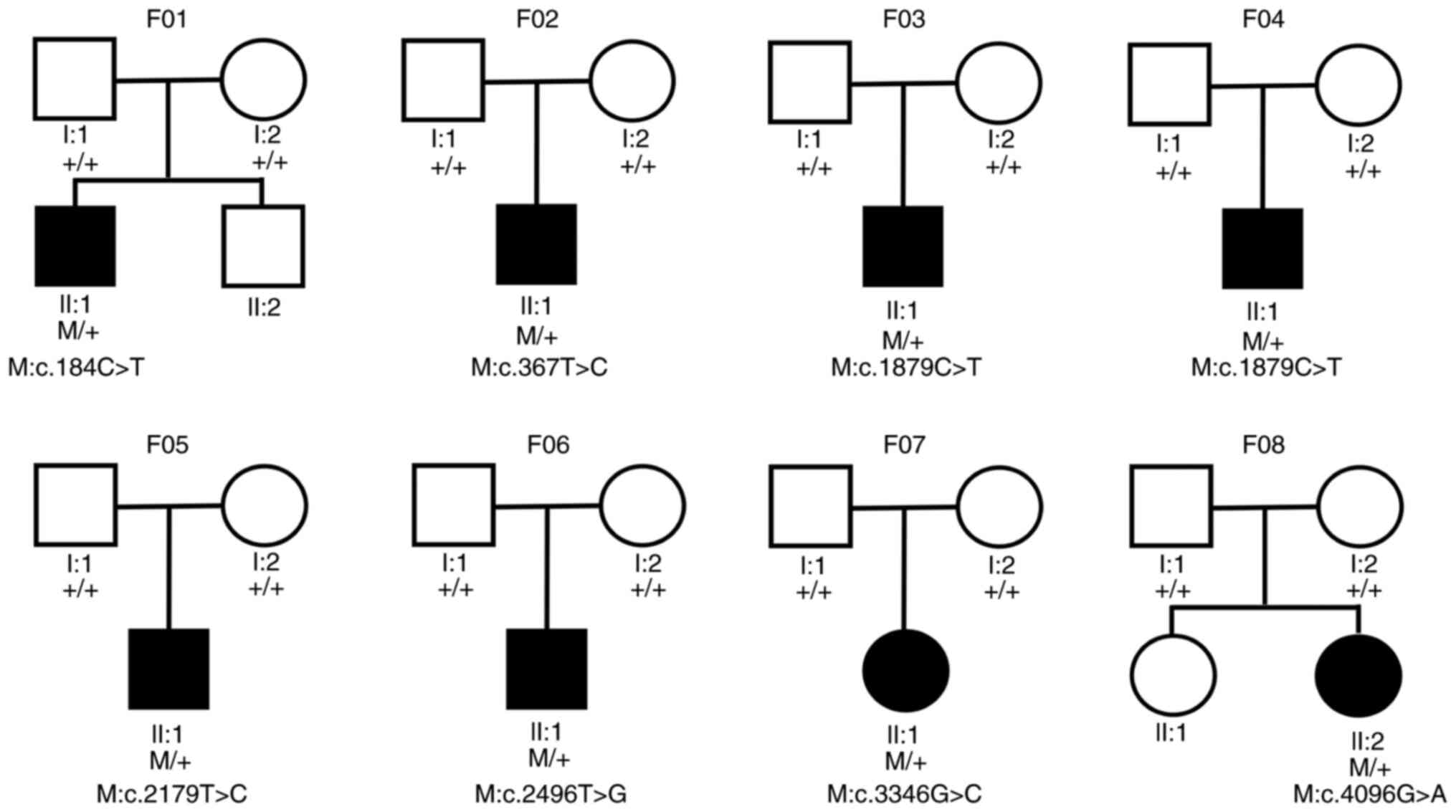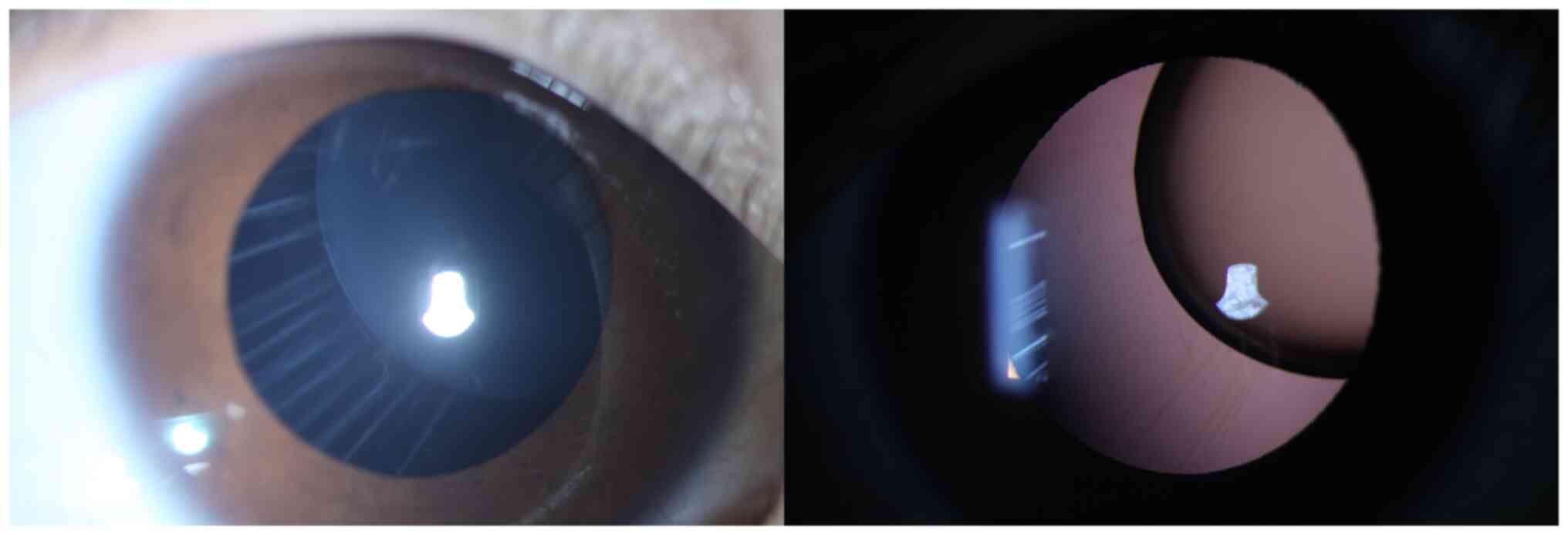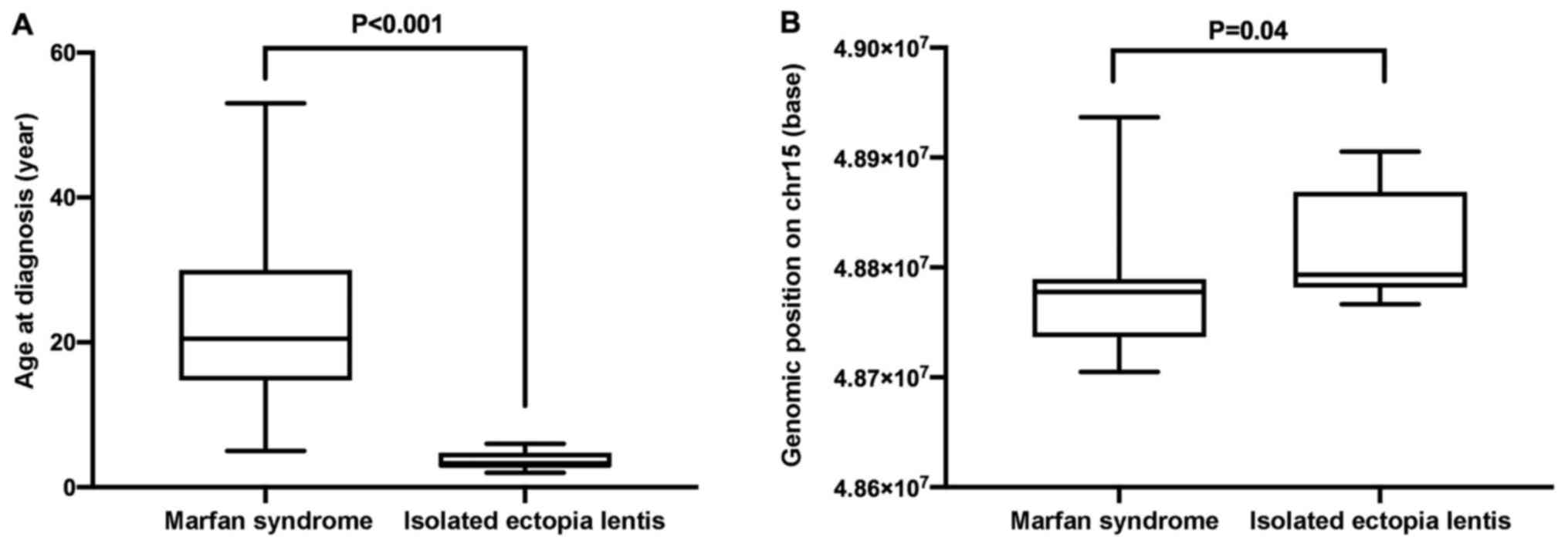|
1
|
Maumenee IH: The eye in the marfan
syndrome. Trans Am Ophthalmol Soc. 79:684–733. 1981.PubMed/NCBI
|
|
2
|
Chandra A and Charteris D: Molecular
pathogenesis and management strategies of ectopia lentis. Eye
(Lond). 28:162–168. 2014. View Article : Google Scholar : PubMed/NCBI
|
|
3
|
Fuchs J and Rosenberg T: Congenital
ectopia lentis. A Danish national survey. Acta Ophthalmol Scand.
76:20–26. 1998. View Article : Google Scholar : PubMed/NCBI
|
|
4
|
Sadiq MA and Vanderveen D: Genetics of
ectopia lentis. Semin Ophthalmol. 28:313–320. 2013. View Article : Google Scholar : PubMed/NCBI
|
|
5
|
Nelson LB and Maumenee IH: Ectopia lentis.
Surv Ophthalmol. 27:143–160. 1982. View Article : Google Scholar : PubMed/NCBI
|
|
6
|
Ruiz C, Rivas F, Villar-Calvo VM,
Serrano-Lucas JI and Cantú JM: Familial simple ectopia lentis. A
probable autosomal recessive form. Ophthalmic Paediatr Genet.
7:81–84. 1986. View Article : Google Scholar : PubMed/NCBI
|
|
7
|
Sinha A and Rahman A: Ectopia lentis in a
family. Indian J Ophthalmol. 28:33–35. 1980.PubMed/NCBI
|
|
8
|
Casper DS, Simon JW, Nelson LB, Porter IH
and Lichtenstein SB: Familial simple ectopia lentis: A case study.
J Pediatr Ophthalmol Strabismus. 22:227–230. 1985.PubMed/NCBI
|
|
9
|
Sakai LY, Keene DR and Engvall E:
Fibrillin, a new 350-kD glycoprotein, is a component of
extracellular microfibrils. J Cell Biol. 103:2499–2509. 1986.
View Article : Google Scholar : PubMed/NCBI
|
|
10
|
Tynan K, Comeau K, Pearson M, Wilgenbus P,
Levitt D, Gasner C, Berg MA, Miller DC and Francke U: Mutation
screening of complete fibrillin-1 coding sequence: Report of five
new mutations, including two in 8-cysteine domains. Hum Mol Genet.
2:1813–1821. 1993. View Article : Google Scholar : PubMed/NCBI
|
|
11
|
Lönnqvist L, Child A, Kainulainen K,
Davidson R, Puhakka L and Peltonen L: A novel mutation of the
fibrillin gene causing ectopia lentis. Genomics. 19:573–576. 1994.
View Article : Google Scholar : PubMed/NCBI
|
|
12
|
Jin C, Yao K, Jiang J, Tang X, Shentu X
and Wu R: Novel FBN1 mutations associated with predominant ectopia
lentis and marfanoid habitus in Chinese patients. Mol Vis.
13:1280–1284. 2007.PubMed/NCBI
|
|
13
|
Deng T, Dong B, Zhang X, Dai H and Li Y:
Late-Onset bilateral lens dislocation and glaucoma associated with
a novel mutation in FBN1. Mol Vis. 14:1229–1233. 2008.PubMed/NCBI
|
|
14
|
Turner CL, Emery H, Collins AL, Howarth
RJ, Yearwood CM, Cross E, Duncan PJ, Bunyan DJ, Harvey JF and
Foulds NC: Detection of 53 FBN1 mutations (41 novel and 12
recurrent) and genotype-phenotype correlations in 113 unrelated
probands referred with Marfan syndrome, or a related
fibrillinopathy. Am J Med Genet A. 149A:161–170. 2009. View Article : Google Scholar : PubMed/NCBI
|
|
15
|
Zadeh N, Bernstein JA, Niemi AK, Dugan S,
Kwan A, Liang D, Hyland JC, Hoyme HE, Hudgins L and Manning MA:
Ectopia lentis as the presenting and primary feature in marfan
syndrome. Am J Med Genet A. 155A:2661–2668. 2011. View Article : Google Scholar : PubMed/NCBI
|
|
16
|
Chandra A, Aragon-Martin JA, Hughes K,
Gati S, Reddy MA, Deshpande C, Cormack G, Child AH, Charteris DG
and Arno G: A genotype-phenotype comparison of ADAMTSL4 and FBN1 in
isolated ectopia lentis. Invest Ophthalmol Vis Sci. 53:4889–4896.
2012. View Article : Google Scholar : PubMed/NCBI
|
|
17
|
Li H, Qu W, Meng B, Zhang S, Yang T, Huang
S and Yuan H: Identification and study of a FBN1 gene mutation in a
Chinese family with ectopia lentis. Mol Vis. 18:504–511.
2012.PubMed/NCBI
|
|
18
|
Yang G, Chu M, Zhai X and Zhao J: A novel
FBN1 mutation in a Chinese family with isolated ectopia lentis. Mol
Vis. 18:945–950. 2012.PubMed/NCBI
|
|
19
|
Faivre L, Collod-Beroud G, Loeys BL, Child
A, Binquet C, Gautier E, Callewaert B, Arbustini E, Mayer K, et al:
Effect of mutation type and location on clinical outcome in 1,013
probands with Marfan syndrome or related phenotypes and FBN1
mutations: an international study. Am J Hum Genet. 81:454–466.
2007. View
Article : Google Scholar : PubMed/NCBI
|
|
20
|
Liang C, Fan W, Wu S and Liu Y:
Identification of a novel FBN1 mutation in a Chinese family with
isolated ectopia lentis. Mol Vis. 17:3481–3485. 2011.PubMed/NCBI
|
|
21
|
Yang H, Ma Y, Luo M, Zhao K, Zhang Y, Zhu
G, Sun X, Luo F, Wang L, et al: Identification of gross deletions
in FBN1 gene by MLPA. Hum Genomics. 12:462018. View Article : Google Scholar : PubMed/NCBI
|
|
22
|
Loeys BL, Dietz HC, Braverman AC,
Callewaert BL, De Backer J, Devereux RB, Hilhorst-Hofstee Y,
Jondeau G, Faivre L, et al: The revised Ghent nosology for the
Marfan syndrome. J Med Genet. 47:476–485. 2010. View Article : Google Scholar : PubMed/NCBI
|
|
23
|
Wang P, Li S, Sun W, Xiao X, Jia X, Liu M,
Xu L, Long Y and Zhang Q: An ophthalmic targeted exome sequencing
panel as a powerful tool to identify causative mutations in
patients suspected of hereditary eye diseases. Transl Vis Sci
Technol. 8:212019. View Article : Google Scholar : PubMed/NCBI
|
|
24
|
Richards S, Aziz N, Bale S, Bick D, Das S,
Gastier-Foster J, Grody WW, Hegde M, Lyon E, Spector E, et al:
Standards and guidelines for the interpretation of sequence
variants: A joint consensus recommendation of the American college
of medical genetics and genomics and the association for molecular
pathology. Genet Med. 17:405–424. 2015. View Article : Google Scholar : PubMed/NCBI
|
|
25
|
Chung BH, Lam ST, Tong TM, Li SY, Lun KS,
Chan DH, Fok SF, Or JS, Smith DK, Yang W and Lau YL: Identification
of novel FBN1 and TGFBR2 mutations in 65 probands with marfan
syndrome or marfan-like phenotypes. Am J Med Genet A.
149A:1452–1459. 2009. View Article : Google Scholar : PubMed/NCBI
|
|
26
|
Yang H, Luo M, Chen Q, Fu Y, Zhang J, Qian
X, Sun X, Fan Y, Zhou Z and Chang Q: Genetic testing of the FBN1
gene in Chinese patients with marfan/marfan-like syndrome. Clin
Chim Acta. 459:30–35. 2016. View Article : Google Scholar : PubMed/NCBI
|
|
27
|
Körkkö J, Kaitila I, Körkkö L, Peltonen L
and Ala-Kokko L: Sensitivity of conformation sensitive gel
electrophoresis in detecting mutations in marfan syndrome and
related conditions. J Med Genet. 39:34–41. 2002. View Article : Google Scholar : PubMed/NCBI
|
|
28
|
Arbustini E, Grasso M, Ansaldi S, Malattia
C, Pilotto A, Porcu E, Disabella E, Marziliano N, Pisani A,
Lanzarini L, et al: Identification of sixty-two novel and twelve
known FBN1 mutations in eighty-one unrelated probands with marfan
syndrome and other fibrillinopathies. Hum Mutat. 26:4942005.
View Article : Google Scholar : PubMed/NCBI
|
|
29
|
Hayward C, Rae AL, Porteous ME, Logie LJ
and Brock DJ: Two novel mutations and a neutral polymorphism in
EGF-like domains of the fibrillin gene (FBN1): SSCP screening of
exons 15–21 in Marfan syndrome patients. Hum Mol Genet. 3:373–375.
1994. View Article : Google Scholar : PubMed/NCBI
|
|
30
|
Zhang L, Lai YH, Capasso JE, Han S and
Levin AV: Early onset ectopia lentis due to a FBN1 mutation with
non-penetrance. Am J Med Genet A. 167:1365–1368. 2015. View Article : Google Scholar : PubMed/NCBI
|
|
31
|
Sakai LY, Keene DR, Renard M and De Backer
J: FBN1: The disease-causing gene for marfan syndrome and other
genetic disorders. Gene. 591:279–291. 2016. View Article : Google Scholar : PubMed/NCBI
|
|
32
|
Baetens M, Van Laer L, De Leeneer K,
Hellemans J, De Schrijver J, Van De Voorde H, Renard M, Dietz H,
Lacro RV, Menten B, et al: Applying massive parallel sequencing to
molecular diagnosis of marfan and loeys-dietz syndromes. Hum Mutat.
32:1053–1062. 2011. View Article : Google Scholar : PubMed/NCBI
|
|
33
|
Seo GH, Kim YM, Kang E, Kim GH, Seo EJ,
Lee BH, Choi JH and Yoo HW: The phenotypic heterogeneity of
patients with Marfan-related disorders and their variant spectrums.
Medicine (Baltimore). 97:e107672018. View Article : Google Scholar : PubMed/NCBI
|
|
34
|
Aoyama T, Tynan K, Dietz HC, Francke U and
Furthmayr H: Missense mutations impair intracellular processing of
fibrillin and microfibril assembly in marfan syndrome. Hum Mol
Genet. 2:2135–2140. 1993. View Article : Google Scholar : PubMed/NCBI
|
|
35
|
Downing AK, Knott V, Werner JM, Cardy CM,
Campbell ID and Handford PA: Solution structure of a pair of
calcium-binding epidermal growth factor-like domains: Implications
for the marfan syndrome and other genetic disorders. Cell.
85:597–605. 1996. View Article : Google Scholar : PubMed/NCBI
|
|
36
|
Comeglio P, Johnson P, Arno G, Brice G,
Evans A, Aragon-Martin J, da Silva FP, Kiotsekoglou A and Child A:
The importance of mutation detection in marfan syndrome and
marfan-related disorders: Report of 193 FBN1 mutations. Hum Mutat.
28:9282007. View Article : Google Scholar : PubMed/NCBI
|
|
37
|
Schrijver I, Liu W, Brenn T, Furthmayr H
and Francke U: Cysteine substitutions in epidermal growth
factor-like domains of fibrillin-1: Distinct effects on biochemical
and clinical phenotypes. Am J Hum Genet. 65:1007–1020. 1999.
View Article : Google Scholar : PubMed/NCBI
|
|
38
|
Stheneur C, Collod-Béroud G, Faivre L,
Buyck JF, Gouya L, Le Parc JM, Moura B, Muti C, Grandchamp B,
Sultan G, et al: Identification of the minimal combination of
clinical features in probands for efficient mutation detection in
the FBN1 gene. Eur J Hum Genet. 17:1121–1128. 2009. View Article : Google Scholar : PubMed/NCBI
|
|
39
|
Liu WO, Oefner PJ, Qian C, Odom RS and
Francke U: Denaturing HPLC-identified novel FBN1 mutations,
polymorphisms, and sequence variants in marfan syndrome and related
connective tissue disorders. Genet Test. 1:237–242. 1997.
View Article : Google Scholar : PubMed/NCBI
|
|
40
|
Zhao JH, Jin TB, Liu QB, Chen C and Hu HT:
Ophthalmic findings in a family with early-onset isolated ectopia
lentis and the p.Arg62Cys mutation of the fibrillin-1 gene (FBN1).
Ophthalmic Genet. 34:21–26. 2013. View Article : Google Scholar : PubMed/NCBI
|
|
41
|
Yu R, Lai Z, Zhou W, Ti DD and Zhang XN:
Recurrent FBN1 mutation (R62C) in a Chinese family with isolated
ectopia lentis. Am J Ophthalmol. 141:1136–1138. 2006. View Article : Google Scholar : PubMed/NCBI
|
|
42
|
Tinkle BT and Saal HM; Committee on
Genetics, : Health supervision for children with marfan syndrome.
Pediatrics. 132:e1059–e1072. 2013. View Article : Google Scholar : PubMed/NCBI
|
|
43
|
Milewicz DM, Michael K, Fisher N, Coselli
JS, Markello T and Biddinger A: Fibrillin-1 (FBN1) mutations in
patients with thoracic aortic aneurysms. Circulation. 94:2708–2711.
1996. View Article : Google Scholar : PubMed/NCBI
|
|
44
|
Hayward C, Porteous ME and Brock DJ: A
novel mutation in the fibrillin gene (FBN1) in familial
arachnodactyly. Mol Cell Probes. 8:325–327. 1994. View Article : Google Scholar : PubMed/NCBI
|
|
45
|
Ahram D, Sato TS, Kohilan A, Tayeh M, Chen
S, Leal S, Al-Salem M and El-Shanti H: A homozygous mutation in
ADAMTSL4 causes autosomal-recessive isolated ectopia lentis. Am J
Hum Genet. 84:274–278. 2009. View Article : Google Scholar : PubMed/NCBI
|
|
46
|
Uyeda T, Takahashi T, Eto S, Sato T, Xu G,
Kanezaki R, Toki T, Yonesaka S and Ito E: Three novel mutations of
the fibrillin-1 gene and ten single nucleotide polymorphisms of the
fibrillin-3 gene in marfan syndrome patients. J Hum Genet.
49:404–407. 2004. View Article : Google Scholar : PubMed/NCBI
|



















